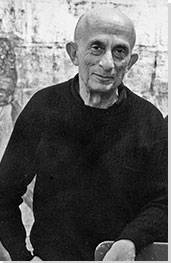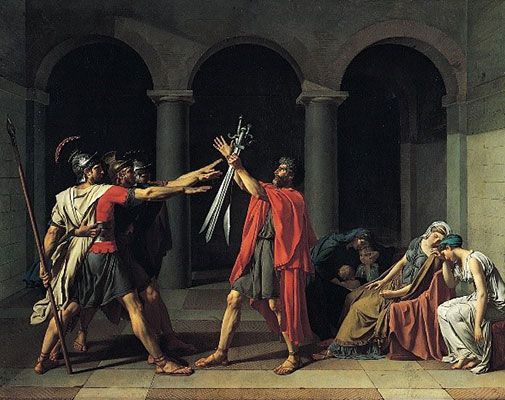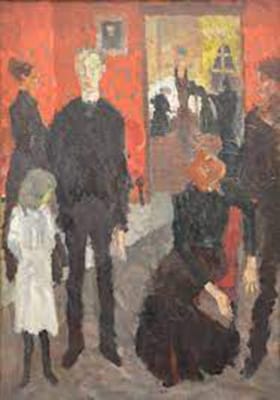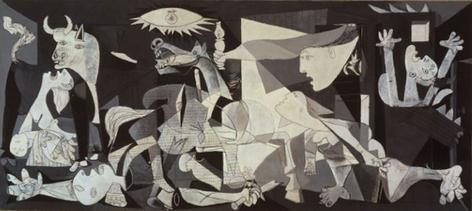Summary of Leon Golub
Leon Golub carried within an unfailing love of people despite his ongoing exploration of the most monstrous scenes of humanity. Still strikingly relevant today, his paintings explore themes of struggle, conflict, and perverse power relations especially in times of war. He was inspired by ancient and contemporary source material alike; a gleaner of information of news stories from popular media, but also a learned classical art historian. Intrigued by the individual, he made portraits of significant personalities, yet simultaneously Golub rejected self-involvement to instead inspire engagement, collaboration, and to situate his art as a call for active resistance against all injustice.
Living in Paris during the early 1960s, Golub and his partner Nancy Spero were confronted by the haunting remnants of the Holocaust. They returned to the United States with an unflinching willingness to confront cultural darkness, only to be eerily greeted by the onset of the Vietnam War. Golub's understanding of the human condition penetrated so deeply that he successfully broke down barriers and transcended boundaries during his own lifetime, for example he was one of only a few white artists invited to be included in the exhibition Black Male: Representations of Masculinity in Contemporary American Art (1994).
Accomplishments
- In tune with his roots, Golub cleverly incorporates his work into the trajectory of European figurative painting. His pictures behold the drama of Expressionism but with unflinching integrity move away from inward angst to explore the same practical, political, and outward reaching worldly goals of the New Objectivity artists (including Max Beckmann, George Grosz, and Otto Dix).
- During the late 1940s, 50s, and 60s Golub's work was often spurned and not given due attention because of the American preference for abstraction, and later, for Minimalism. Due to Golub's perseverance, and to that of other individual artists, in the late 1970s, Neo-Expressionism emerged and the revealing power of figuration was once again revived.
- Golub makes paintings that also have sculptural, drawing, and tapestry-like qualities and thus challenges the viewer's perception of what makes a painting. Thick paint is scraped and moulded on application and un-stretched and un-framed canvas make the works appear as though works on paper or fabric hangings. As such, by using apparently endless backgrounds, Golub successfully translates ideas and intentions that cannot be easily contained or concluded.
- Like his wife and fellow artist, Nancy Spero, Golub believed in absolute equality and the destruction of hierarchy. The duo were aware that together their work was stronger and intentionally worked in parallel to provide the greatest of insights into the human condition. Like two sides of the same coin, Golub investigated male glory, aggression, and violence, whilst Spero focused on the subordination and regenerative powers of women.
Important Art by Leon Golub
Gigantomachy II
Golub began to paint images of men, specifically heroes, in classic moments of extreme glory and demise. Stemming from his acknowledgment and disdain for the fact that men ruled the world, whilst simultaneously looking at classical statues and popular athletic poses, writing frieze-like scenes of masculine struggle emerged. In this particular work, ten nude male figures engage in a frantic battle. Their fleshy, intertwined, thickly traced limbs suggest violence, mutilation, and slaughter. The lack of references, such as a recognizable background, or a defined character, refers to an eternal and meaningless state of violence; there is no information in regards to the cause of the battle, or a signifier indicating what may divide the group of characters: they are just fighting.
Golub used a series of Hellenistic references to develop his paintings. The horizontal arrangement of the figures in Gigantomachy II is reminiscent of those of ancient Doric friezes. Furthermore, the title directly references a Greek mythological battle between the gods and the giants. Art critic and historian Thomas McEvilley described this painting as "an allegorical picture of history", " a meaningless and endless battle." The at once fleshy quality of the figures resulting from the superimposition of thick paint, combined with the skeletal aspect determined by the use of the color white, together make these figures anonymous, unfinished, and representative of both anyone and everyone. Through this universal scene, Golub formulated a critique, albeit still relatively indirect and abstract, of the violence of his time, a period marked by the Vietnam crisis.
Acrylic on linen - The Metropolitan Museum of Art, NY
Vietnam II
Marking a shift from previous work, Vietnam II is an exceptional example of Golub's dramatic large-scale figurative style that explicitly addresses contemporary issues, here the Vietnam War. Over three metres high and twelve metres long, the composition is divided into two parts: on the left hand side American soldiers direct their weapons towards frightened Vietnamese civilians at the opposite side of the already torn canvas. The gestural dialogue between these two groups is striking; the weapons of the aggressors prepare to fire on the screaming victims; the violence of the soldiers provides contrast to the fear of the civilians, and most notably to the look of terror expressed by the boy at the forefront of the picture. In suitable symbolic guise, the aggressors wear black and point their protruding guns, whilst the innocents are clothed in white and curve their arms in attempt to shield one another.
In these, the largest and most physical paintings of his career, Golub adopted an active stance against the Vietnam War, engaged with the progression of the conflict throughout the Vietnam series. These works become less obviously concerned with ancient art and more with real and present atrocities that were even being televised at the time. The canvases dealing with the inexhaustible fall of man narrative are literally themselves physically broken. Departing here from any art historical source material, Golub would draw the figures directly onto un-stretched canvas looking at horrific and shocking images from contemporary newspapers and magazines. Art historian and Golub-expert Jonathan Bird observed that while "the scale and arrested action invoke cinema [...], the compositional structure, accuracy in dress and weaponry, close-up detailing of expression and gesture, all reference a spectacularized culture saturated with mass-media imagery."
Acrylic paint on canvas - Collection of the Tate, United Kingdom
Portrait of Francisco Franco
Between 1976 and 1979 Leon Golub worked on a series called The Political Portraits. The result is over a hundred heads of dictators, state, military, and religious leaders. These portraits, as most of Golub's figurative work, can be read as active critiques of organized political violence. They are further subversive in the way that they forefront frailty in usually considered invincible figures. Golub entirely shatters the idealization of powerful men, interestingly focusing on the inevitable mortality of all. Francisco Franco for instance is depicted as an old man. As well as a cruel Spanish dictator, who once appeared to have everlasting power, Franco becomes simply a man who will soon die and physically disappear.
Golub said of this work and others from the same series, "I think of the political portraits as skins or masks". He wants to reveal that to take hold of power is little more than an illusion. The recurrent visceral quality of this portrait of Franco, the skin tones and rendering of facial lines, result in a likely and realistic presentation of the dictator. The portrait was not painted from life, but from a culmination of magazine photographs and television images. As such, Golub made optimum use of public material as a means to engage with political reality. Through this process, the artist inverted the set of social relations that portraiture commonly entails; the sitter did not choose to be portrayed and the final image was not meant to be flattering in any way. With chilling reassurance, the series comments that even the most aggressively 'powerful' are not able to resist the progress of degeneration.
Acrylic on linen - Ulrich & Harriet Meyer Collection
Interrogation II
Interrogation II belongs to a series of works denouncing American neo-colonialist interventions in Latin America. In this large painting, four mercenaries surround their naked, bound, hooded, and tortured victim. The provocative perverse glance of two of the mercenaries on the right hand side, combined with the warning background color of red, dare the viewer to maintain eye contact with this frightful, unaccountable, and unnatural scene. Both in palette and in the grotesque depiction of the aggressors, the canvas recalls some of Golub's artistic inspirations. The German New Objectivity artists (including George Grosz and Otto Dix), as well as the Belgian Expressionist painter, James Ensor, portrayed the demise of human behaviour in times of conflict, the easy onset of chaos, and absolute abuse of power.
Whereas the same fleshy quality from earlier paintings such as Gigantomachy II (1966) can still be seen, in this series, Golub has endowed his characters with individual traits, each character is given a specific personality, and their clothes and weapons ground them firmly in the present time. Perhaps this is Golub's own attempt to make these individuals somehow accountable for the crimes for which they will likely never pay, maybe one day someone will recognise them and 'justice' will be served posthumously. Interrogation II was painted without a stretcher: the canvas was instead hung directly on the wall. The painted surfaces acquired thus an uneven quality and a raw texture that reinforces the expressionistic and dramatic quality of the scene. Golub defined the role of the artist as an active agent for change, and Interrogation II is indicative of the artist's willingness to engage with the atrocities of his present. His figuration was thus intended to reveal, denounce, and criticize. And as he stated himself: "I am bringing into your space the real world pressures".
Acrylic on canvas - The Art Institute of Chicago, IL
Two Black Women and a White Man
When Golub turned his attention to the issue of Apartheid in South Africa, he made sure to explore the systems of social hierarchy and power relations from an everyday perspective. In Two Black Women and a White Man, three characters stand in two separate groups without making eye contact. The white male figure stands tall on the right and turns his gaze away from the two black women who sit on the left in a separation evocative of literal hierarchy and passive, almost nonchalant aggression that well defined the deeply engrained South African apartheid racism.
The viewer confronts another actual and current social injustice as opposed to the mythological universe that began Golub's career. The scraped quality of the figures, recurrent in Golub's work, enhances the overarching sentiment of misery and fragility. It also makes reference to the transience and non-containable quality of life, like pictures painted as frescos or murals in graffiti, there is a sense to this painting that it is not to be separated as 'art' in a gallery, but rather that it is somehow more and intended to be part of everyday existence. The network of glances, the left-hand lady's look directed to the viewer, and the central female figure's eyes fixed on the male character, is both dynamic and challenging. It is the women who seek to make connections and start dialogue, whilst the man actively rejects this. Golub asks, is the spectator a passive viewer or an accomplice? "One claims to support humanist values, liberal points of view", explained the artist, "But maybe at some level you're identifying with those guys, deriving a vicarious imaginative kind of pleasure in viewing these kind of macho figures."
Acrylic on canvas - Ronald Feldman Gallery, New York
All Bets are Off
During the 1990s, Golub's work continued to address themes of mortality and conflict but his palette became more vibrant and his scenes less narrative. His painting shifted toward the illusionistic, with forms semi-visible, placed together in collage-type formation making reference to ancient carvings, medieval manuscripts, and contemporary graffiti. Text appeared in many of these paintings which typically combine a series of symbolic references, including dogs, lions, skulls, and skeletons.
All Bets are Off features a dog, a crystal skull, and a tattoo motif composed of a dagger pierced heart, a white rose, and a snake slithering behind the word 'despoiled'. These elements do not cohere into any specific narrative; they are instead disjunctively positioned on a neutral background and in this respect recall the works of Symbolist paintings, including those of James Ensor and Odilon Redon. Interested in the bestial and degeneration as in earlier works, but here Golub looks through a lens of universal spirituality and appears to leave a more worldly gaze out of it. More like the work of Nancy Spero, we are confronted not with a whole and believable scenario, but instead with fragments united within the imagination.
In his reading of All Bets are Off, Jon Bird observed that "These iconographically rich paintings combine 'high' and 'mass' cultural references that push narrative content to the edge; complex metaphors of life and death, desire and the body, they construct a dialect of the beautiful and the sublime which touches upon our mortality and the struggle for identity."
Acrylic on linen - Private Collection
Biography of Leon Golub
Childhood/ Early Adulthood
Leon Albert Golub, known as Leon Golub (1922-2004) was born and raised in Chicago, Illinois. Son of Jewish immigrants from Ukraine and Lithuania, Golub started making art from a young age. He initially intended to become an art historian and attended the University of Chicago where he received a BA in Art History in 1942. In particular, his studies in ancient Greek and Latin greatly influenced his work and would later become visible in his paintings. He drew inspiration from Greek tragedy and mythological scenes, as well as from Roman sculpture. While a student, in 1939, he saw Pablo Picasso's Guernica at the Chicago Arts Club; this image made a great impact on the young artist and powered his passion towards a highly political, and socially engaged creative vision. As he explained: "Guernica was like that. It was an art object that dealt with our world, OK? I was interested in seeing what that world looked like and was to a certain extent politically aware."
After serving in the military during World War II as an army cartographer, Golub attended the School of the Art Institute of Chicago (SAIC) and received his BFA in 1949, followed by an MFA from the same institution in 1950. It was at SAIC that Golub met his future wife and lifelong artistic companion, the artist Nancy Spero, whom he married in 1950. Four years his junior, Spero's quiet and introverted character provided seeming contrast to Golub's voluble demeanour. They shared, however, a relatable unapologetic figuration and curiosity towards art from all times and places. In some ways incomparable, but in others expediently connected, their art grew through their constant exchanges and conversations: "We lived and worked together", Spero said, "and it was pretty wonderful - a perpetual dialogue. The influence was mutual." Like artist scavengers, the couple would often frequent the Field Museum in Chicago and plunder any medium, newspapers, porn-magazines, and photographs, in their quest for inspirational images. They did not distinguish between 'high' and 'low' art in any way, any material, once expertly selected and then collated together was useful in the dissemination of meaning.
Early period
Golub became involved with other painters in Chicago forming a group known as the Monster Roster, a name given by art critic Franz Schulze in the late 1950s. Many of the members frequented the School of the Art Institute of Chicago, and they were united by an affinity for expressive figuration, in particular by the fleshy and sometimes ghastly quality of their figures. They shared the belief that art had a strong role to play in society; it had to highlight and make reference to the real harm and gruesomeness present in the world, in the hope that this negativity could be at least a little diminished. Golub rejected the passiveness of his Abstract Expressionist peers (known as the New York School) finding their work too detached from reality. "I was never interested in abstract art", he stated, "There were things missing." This was a stand taken that would inform Golub's work for the rest of his career.
Encouraged by the belief that his figurative style would be better received in Europe, Golub and Spero moved to Italy in 1958 before then moving to Paris in 1959. During that time the couple had three sons: Steven, Philip, and Paul. Golub worked in what he called a "universalizing mode". Austere, beastly, and existentially fatalistic, his early work reflects on human violence, male domination, and despair without referring to any specific context or time. Such paintings combine pictorial elements of late classical sculpture as well as mythical themes, and in their colossal size are reminiscent of the French-history paintings that Golub studied and admired. Golub applied generous amounts of paint, which he spread with a butcher's cleaver throughout the surface. His technique resulted in fleshy and sculptural figures emphasizing the brutality of the scenes depicted, well exemplified in his Gigantomachies series.
Mature Period
Golub returned to New York with his family in 1964. "We lived in an old industrial loft for a while", remembers his son Philip, "very bohemian, and then we moved to an apartment because my parents thought that raising three kids in that particular loft wasn't absolutely perfect".
New York was flooded by protests against the Vietnam War, which Spero and Golub ardently joined. Seeking to engage and actively criticize the inhumanness of the conflict, Golub's studio became an anti-war activist centre while -art wise- he slightly changed his subject matter to add real-world references to specific time and place. He sought to add contemporary relevance to his paintings: "I was then very uncomfortable with the gap between my work and the current political circumstances" he explained. This shift became visible in Golub's Vietnam series (1972-74). In these large-scale un-stretched canvases, uniformed American soldiers and screaming Vietnamese civilians are recognisable by their clothing thus marking a rupture with his previously naked, timeless, and anonymous figures.
These epically holocaustic depictions were followed by a crisis of self-doubt between 1974 and 1976. Dissatisfied with his situation as an artist, poor success, shadowed by the influence of Minimalism and Conceptual Art in the New York art scene, Golub scaled down his work to make political portraits, usually even smaller than life-size. These portraits featured political leaders, dictators, and religious figures typically drawn in profile or turned away from the viewer. They were not typical heroic portraits, and as such Golub, questioned the legitimacy and so-called power of the figures shown.
Late Period
In the 1980s Golub turned his attention to terrorism while expanding his repertoire of forms. Departing from material such as photographs of the body in motion or images from art history, Golub depicted scenes of torture chambers, aggressive interrogation, oppression, and racial inequity to name but a few. These works are the documents of unjust crimes of repression; indeed the expressive faces of the victims and the detached gnarly stares of the torturers subjugate the viewers into the harshest of embodied violent reality. Among the most well known work produced during this period are the Interrogation and Mercenaries series. This dramatic and assured figuration brought Golub long awaited public and critical recognition. He had his first solo exhibition in New York in 1982 and by the end of the 1980s, Charles Saatchi had begun to collect his work. No longer alone on his quest, this was the moment when many other artists also began to reject Minimalism and focus attention on the figurative once more. Jean DuBuffet and Jean-Michel Basquiat were among these. DuBuffet, like Golub had been making such figurative work for many decades and is famous for founding the art movement, Art Brut, also influential for Golub.
The 1990s saw another remarkable, and final, shift in Leon Golub's work: chaos, death, dogs, and skulls scattered in symbolist formation to create mysterious, more internal, and often dystopian scenarios. In this sense, working in a more fragmented way, piecing together elements in a collage-like manner, in 1996 Golub was suitably invited to design four stained glass windows depicting the life of Joseph for the Temple Sholom in Chicago.
Relentlessly engaged in politics, art, and his own identity, Golub died aged 82, in New York on August 8, 2002.
The Legacy of Leon Golub
Golub's uniquely expressive figuration and representation of universal human cruelty has a resonance across all time and culture. Although much of Golub's most troubling and memorable work was made in relation to the U.S. involvement in the Vietnam War, the scenes are now interchangeable with those since witnessed in Iraq, Afghanistan, and Syria. Thus the work has inspired an entire generation of artists in the United States and abroad, with regard to the representation of war. The influence of his paintings, with regard to the male body fighting and more generally the dark side of humanity, can be seen in particular in the work of contemporary LA based artist, Cleon Peterson, and in the paintings of the London based, Marcelle Hanselaar.
It was long before it was fashionable for artists to attack current USA conflict endeavors that Golub was making his voice heard with regard to the Vietnam War. His overtly harsh visual commentary on wartime struggle, and particularly in opposition to Vietnam, has been embraced by a number of artists. Peter Saul blended expressionism and figuration, albeit using a much more 'pop' aesthetic, to respond to controversial themes leading to unsettling conclusions. Similarly, and more recently, film director and artist, Steve McQueen has also engaged in opinionated anti-conflict visual narratives in his work. Furthermore, the textural quality of Golub's style endows his figures with a three-dimensional 'life' beyond the flat canvas, and as such his technique bears reference to the paintings of Anselm Kiefer.
Golub's work is testament to the fact that regardless of styles and movements that tend to come and go, there is a thematic aspect of art - interest in the eternal pains of humanity - that forever remains unchanged. Although well known and respected since the 1980s, it was not until 2015 that the Serpentine Gallery in London held a large career retrospective of Golub's work. Hauser and Wirth in New York, followed suit, and had a similarly serious show in the same year.
Influences and Connections

-
![Expressionism]() Expressionism
Expressionism -
![New Objectivity]() New Objectivity
New Objectivity -
![Neo-Expressionism]() Neo-Expressionism
Neo-Expressionism - Hellenistic Art
- Primitive Art
-
![Nancy Spero]() Nancy Spero
Nancy Spero -
![Anselm Kiefer]() Anselm Kiefer
Anselm Kiefer - Cleon Peterson
- Peter Siegel
- Seymour Rosofsky
- Chicago Imagists
- Monster Roster
Useful Resources on Leon Golub
- Leon Golub: Images of the Real: Echoes of the RealOur PickBy Jon Bird
- GolubBy Leon Golub, Lynn Gumpert, Ned Rifkin
- Leon Golub: Existential/Activist PainterBy Donald Kuspit
- A Painter of Darkness : Leon Golub and our TimesBy Gerald Marzorati
























